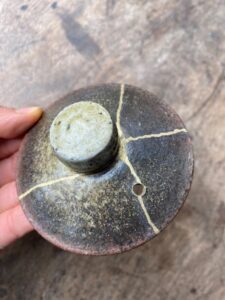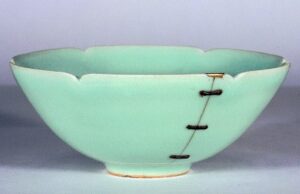Have you heard of ‘Kintsugi’ before?
You might have seen ceramic pieces with golden lines and wondered what they are.
‘Kintsugi (金継ぎ)’ which translates as ‘golden joinery’, is the old Japanese craft of repairing broken pottery. They were mended with lacquer called ‘urushi (漆)’ and dusted with gold, silver, brass or tin powder, using the ‘makie (蒔絵)’ technique as decoration. As you can imagine, in stark contrast to the super-glue-quick-fix of today, this process requires time, patience and care.


One theory of its origins is that in the late 15th century, the Japanese shogun Ashikaga Yoshimasa (足利義政), who had deep understandings in the culture of Japanese tea ceremony (茶道), sent his favourite tea bowl back to China to be repaired. But when the piece returned, he wasn’t satisfied with the appearance of dark metal staples used on the delicate tea bowl (see image below), and this prompted him to order his Japanese craftsmen to look for a better way of repairing them.
Celadon Tea bowl ’Meibakouhan’
Alongside the practical wish to repair a prized pot, was the appreciation that the repair itself would invariably enrich the beauty of the pot, both aesthetically from the effects of high lighting the lines of the joined pieces, and philosophically in terms of celebrating the ability of something so small and fragile to weather the trial and tribulations of life.
With this in mind, the damages are carefully mended and shown proudly with your choice of finishes, to enhance the stories of the breakages, rather than to hide them. This adds to the pot’s uniqueness, and it is not hard to see how they may be viewed as a reflection of our own lives. It celebrates imperfection and reminds us that for a healthy state of mind, we should only pursue perfection so long as we never hope to achieve it! Hence Kintsugi, like wabi sabi (侘び寂び) is seen as a celebration of the imperfection.
Although this craft has been around for centuries, many Japanese weren’t familiar with it, and I too was one of them. In recent years it is seeing a renaissance in Japan and it is wonderful to see this intriguing craft being widely practiced, not only in Japan but all over the world. I am happy to be a small part in this movement: Instead of throwing broken pottery away, we should take care in repairing them and enjoy looking after them into their old age.
Happy mending.

